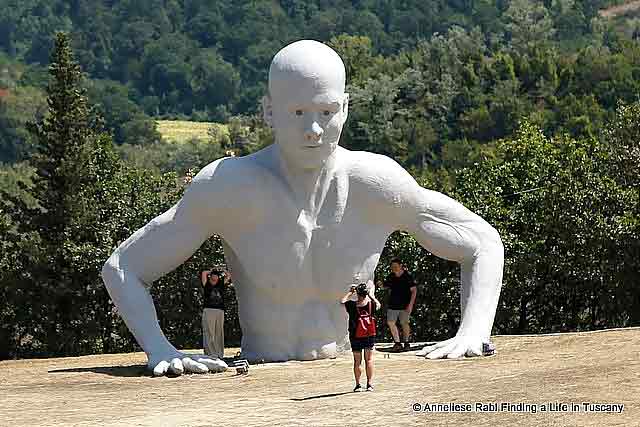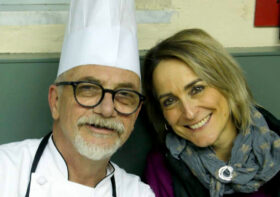The giants of Peccioli

I never thought that I would say this. Never. And yet, sometimes it occurs to me what happens to more and more people, that is a certain indifference regarding centuries old traditions and ancient history.

Whenever I decide to visit a Tuscan hamlet I know that there will be monuments and memorial plaques telling me about war and peace treaties between Livorno, Pisa, Lucca, Florence, San Gimignano, Volterra and Siena (not necessarily following this chronology). Most likely I will find all sorts of information regarding changes of huge ownerships, the construction of churches, monasteries, palaces, towers and castles throughout many centuries. Leading families with the proper coat of arms clearly visible on the facades of their properties will recall me their deeds and misdeeds. And I will learn that quarrels, peoples’ uprisings, strategic moves and treasons have almost been commonplace.
With all this in mind I wanted to visit Peccioli in the province of Pisa in Tuscany a couple of weeks ago. Why Peccioli? Because on the website of the Theatre of Silence located in the nearby Lajatico, I have seen images of huge statues which attracted my attention. The giants were brought over some years ago from Peccioli for a performance hosted only once a year. Besides this, the small village apparently has turned into a true place for modern art from 1995/2000 onwards. The deep rooted inhabitants of a municipality in the province of Pisa accept modern art invading their ancient hamlet rich in history and centuries old tradition? A little hard to believe.

The streets leading to my destination were good to drive on and well marked (not to be taken for granted), the whole hinterland of Pisa, by the way. At a certain point out of nowhere appeared the first of the four giants I wanted to see. He was in fact remarkably tall and artfully created. Unfortunately, since he was crouching on the roof of a building I could not come too close.


Students from England who were playing soccer in a nearby parking area explained to me where I would find the other sculptures. In fact, it was not difficult to locate the second one. Immersed in the earth up to his waist, the handsome man was easy to reach. His position next to an amphitheater, surrounded by the breathtaking view over the Valdera region, really underlined the beauty and particularity of the giant. Excellent work from the employees of the company, Naturaliter, the author. Fantastic artists, indeed.

There were still two more masterpieces I wanted to photograph which I would find in a landfill. A waste disposal site? This, honestly, struck me as odd. So, after driving a few kilometers I ended up in front of the so called Green Triangle gate, from where I could see the two statues down the hill in the distance. Once given my name, surname and phone number the gate opened automatically and I entered the landfill covering thirty five hectares.
How did I know that it covers thirty five hectares? Because an employee had told me so. How could I have a word with an employee given that the entrance is without talking to people in flesh and bone? Because while passing the gate instead of driving to the right I took the road to the left. After a few hundred meters I realized my mistake and turned the car around to drive back. In the entire landfill there was only one single muddy puddle to get bogged down and I drove right into it.

So, in the early afternoon under the blazing August sun I walked back to the gate and ask for help. A young man arrived at once with the necessary equipment to pull the car out of the mud. The quick professional first aid make me hope that I was neither the first nor the last visitor with a similar problem. A small consolation for my wounded pride.

Something told me that my savior was not sure about my driving abilities. In fact, he offered to accompany me down to the sculptures. It was he who told that about twenty years ago the town council under the guidance of mayor Renzo Macelloni, inspired by models from Nordic countries, decided to renovate and clean their landfill. Up to then nobody felt responsible for the huge environmental, structural and organizational problems of the place.

Slowly slowly with the help of far-sighted people and smart fellow citizens the waste disposal site has been transformed into today’s model company. It is able to dispose and partly transform into energy not only the proper waste but the one from other regions, too. Today, the landfill has become strategic for Tuscany regarding renewable energy and research.

All this brought substantial economic well-being which the town council invests in infrastructures and services aimed to enhance the value of the territory, the tourism and the cultural heritage. Besides, a lot of attention is given to the fine arts in general and the purchase of contemporary artwork. This is the mystery revealed.
The only thing left for me to do was shooting photos of the remaining sculptures, a woman and a man, both huge as the others. In the middle of a landfill two white human giants, not drowned by garbage but reborn and rising from it. Desirable metaphor.

In the end I drove up the small hill to visit Peccioli. The coexistence of ancient history (tabernacle of Benizzo Gozzoli) and contemporary art (David Tremlett and the others) with fields and meadows as far as the eyes can see as scenography is really surprising, you could say one of a kind. If I consider that we are in Tuscany, known for its attachment to deep rooted traditions, I can’t help but applaud. Chapeau. Hats off.

















Leave a Reply